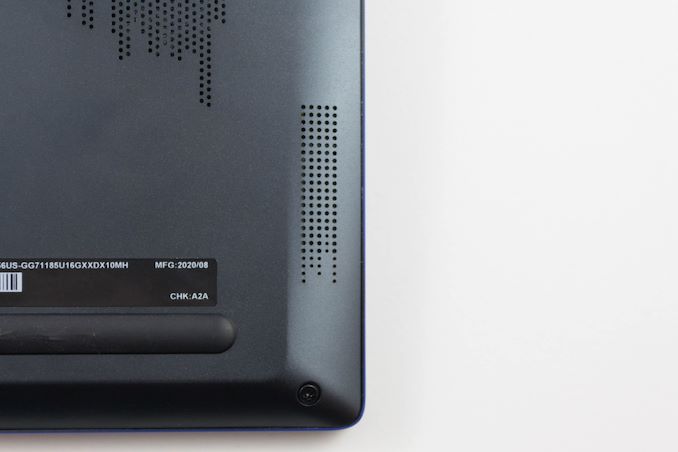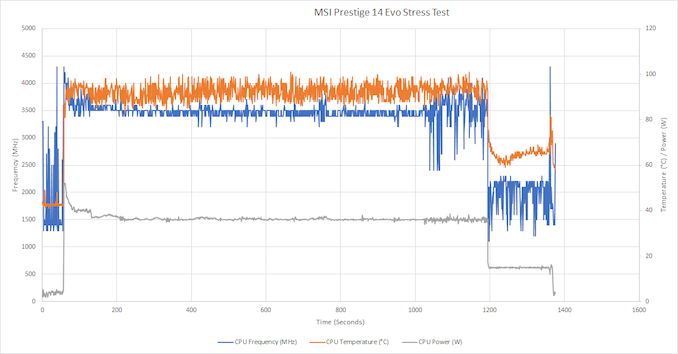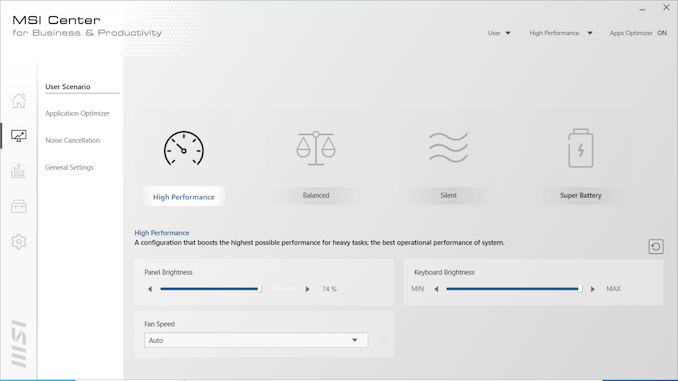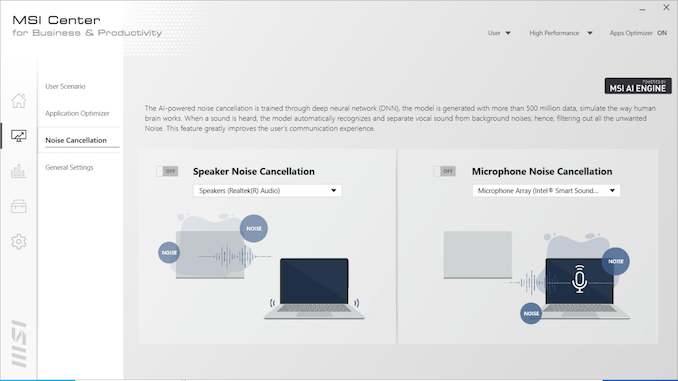The MSI Prestige 14 Evo Review: Testing The Waters Of Tiger Lake
by Brett Howse on December 17, 2020 10:00 AM EST- Posted in
- Laptops
- Intel
- MSI
- Tiger Lake
- Notebook
Wireless
As an Intel Evo device, Intel requires that the manufacturer include Intel’s Wi-FI 6 adapter, and luckily for all, that is not a burden on any device at the moment. Intel has continued to deliver the best Wi-Fi solutions in the industry. The MSI Prestige 14 Evo features the Intel AX201 Wi-Fi 6 network adapter. As a Wi-Fi 6 solution, it supports 160 MHz channels and 1024 QAM.

Performance is fantastic, with a maximum transfer rate of almost 1500 Mbps, easily eclipsing Gigabit Ethernet at short-range transfers. Intel’s driver stack is also one of the most reliable in the industry. The laptop never struggled with connections or resuming from sleep.
Audio
In a fairly typical setup, the MSI Prestige 14 features stereo speakers that are downwards firing, located at the front of the laptop. As is also typical in a thin and light design, there is not a lot of room for the drivers themselves. The speakers do not get very loud, hitting about 72 dB(A) measured an inch over the trackpad, and due to the small size of the drivers, there is not very much low-end punch.
Thermals
The terms thin, light, and high-performance don’t always go together, but we’ve seen the lines blurred in the last several years with some very impressive designs. The biggest challenge of any thin and light design is being able to dissipate the heat produced under load, due to a lower thermal mass and less airflow from the smaller designs. Adding to that challenge is Intel really pushing the limits of power draw in a small form factor, with high burst-power draw and now higher and higher sustained power draw on the latest devices. Intel has traditionally offered its U-Series chips as a nominal 15-Watt design, but the latest 10 nm designs have dropped the U and with Tiger Lake, have dropped the nominal TDP value altogether. Intel now specifies its Tiger Lake processors with a TDP range – in this case 12 to 28 Watts.
MSI offers a couple of difference performance modes which change the TDP of the processor significantly. The High Performance mode pretty much gives the CPU free reign, while the silent mode caps the system to a more typical 15-Watt TDP for the processor. To see how the device handled prolonged stress, it was run at 100% CPU load while monitoring temperatures and power draw.
In the High Performance mode, MSI has basically uncapped the CPU power draw. The CPU runs at an all-core turbo of 4.3 GHz initially with a peak power draw of almost 52 Watts, and then settles down to a sustained 30-Watt draw for the duration with the CPU frequency around 3.5 GHz. Rather than use power draw as a cap though, the processor is bouncing off the 100°C temperature limit, and throttling based on that. Near the end of the test, the laptop was switched to the Silent mode, which drops the power draw to just 15 Watts, which dramatically drops the CPU temperature, of course at the expense of frequency. MSI is very aggressive here. It is not very often we see a processor using the temperature limit as an upper limit on performance for such a sustained duration. Generally the device will cap power draw to a level that the device can more easily handle.
The good news is that this does remove the performance restriction for the end user, and the owner can choose the performance level based on individual needs and requirements. The bad news is that this does cause some significant noise from the system fans, which peaked at 52.4 dB(A) measured one inch over the trackpad. Compare this to the silent mode where the system fan is on but barely audible at just 37 dB(A) measured in the same location. The system has a very wide range of usability, and can be completely silent, to extremely loud, depending on how you want to use it.
Software
Practically every laptop now comes with some sort of control center, which lets you access specific device settings, as well as support options, and the MSI Prestige comes with the MSI Center for Business & Productivity. It is not the most elegantly named software suite, nor is it the best designed, but it does offer some good functionality.
As tends to be the case, the built-in suite is the easiest way to update drivers, and MSI’s Live Update is a great way to keep system drivers up to the latest versions. It allows you to quickly scan and download updates for Thunderbolt, audio, wireless, and other included hardware. It does not appear to allow BIOS updates, although it does at least display the current BIOS version information.
There is also the Optimizer options which let you choose the system performance and fan profile, as well as choose whether the Windows key is enabled, and to switch the Fn key with the Windows key.
MSI also includes a noise cancellation option, which uses the microphone to sense the ambient noise and attempt to cancel out some of the system noise. While this would be amazing to cancel out some of the sound from the system fans, it is only used for communication, which is unfortunate.
MSI also includes a couple of trial-ware software, such as Norton AV, and some Cyberlink products for media editing such as ColorDirector, AudioDirector, Music Maker, PhotoDirector, and PowerDirector. Luckily, if they are not needed, they can be uninstalled directly from the start menu.
















63 Comments
View All Comments
Spunjji - Friday, December 18, 2020 - link
I can accept this rationale on a device that has 2 or 3 USB 3 A ports along with the USB 2 port, but when it's the only USB A port on the device it's a poor showing. It's a bit premature to refer to any storage device not using USB-C as "legacy".Deicidium369 - Thursday, December 17, 2020 - link
Not like you would REALLY be a customer ...tipoo - Thursday, December 17, 2020 - link
Any impressions on how the Intel publicized Ryzen 10 second boost delay on battery impacts real world system responsiveness?Smell This - Thursday, December 17, 2020 - link
**The CPU runs at an all-core turbo of 4.3 GHz initially with a peak power draw of almost 52 Watts, and then settles down to a sustained 30-Watt draw for the duration with the CPU frequency...**_________________________________________________
Would be nice if AT actually identified the X-axis title and time scale.
INCREDIBLY DISAPPOINTED on how this has been presented.
Brett Howse - Thursday, December 17, 2020 - link
In what has been a difficult year for everyone, I can see how this lapse in my judgement has hurt significantly. I apologize, and have updated the offending table.lmcd - Friday, December 18, 2020 - link
This travesty will likely shake the earth to its core. Next earthquake's on you bud ;)Smell This - Friday, December 18, 2020 - link
Thanks, BrettNo worries, Mate
henkhilti - Thursday, December 17, 2020 - link
Looks like 36W sustained to me, not 30W.phoenix_rizzen - Thursday, December 17, 2020 - link
So Intel's top-of-the-line Tiger Lake CPU trades blows with AMD's second-best, last-gen APU. Not sure if I should be impressed with how well AMD is doing these days, or depressed by how far Intel has fallen. It should be worrying to Intel's marketing team that a low-end brand like Acer Swift can compete so well with a top-end EVO-branded laptop. Wonder how they're going to spin that?It's nice to see actual competition in the laptop space, though. AMD 4000-series APUs, Intel Tiger Lake, AMD 5000-series APUS, Intel's next gen (forget the name). Will be an interesting 2021 for laptops. :)
yeeeeman - Thursday, December 17, 2020 - link
Where is current gen AMD APU if 4700U is last gen?4700U is still current gen until we get 5000 series products which will happen in march next year.